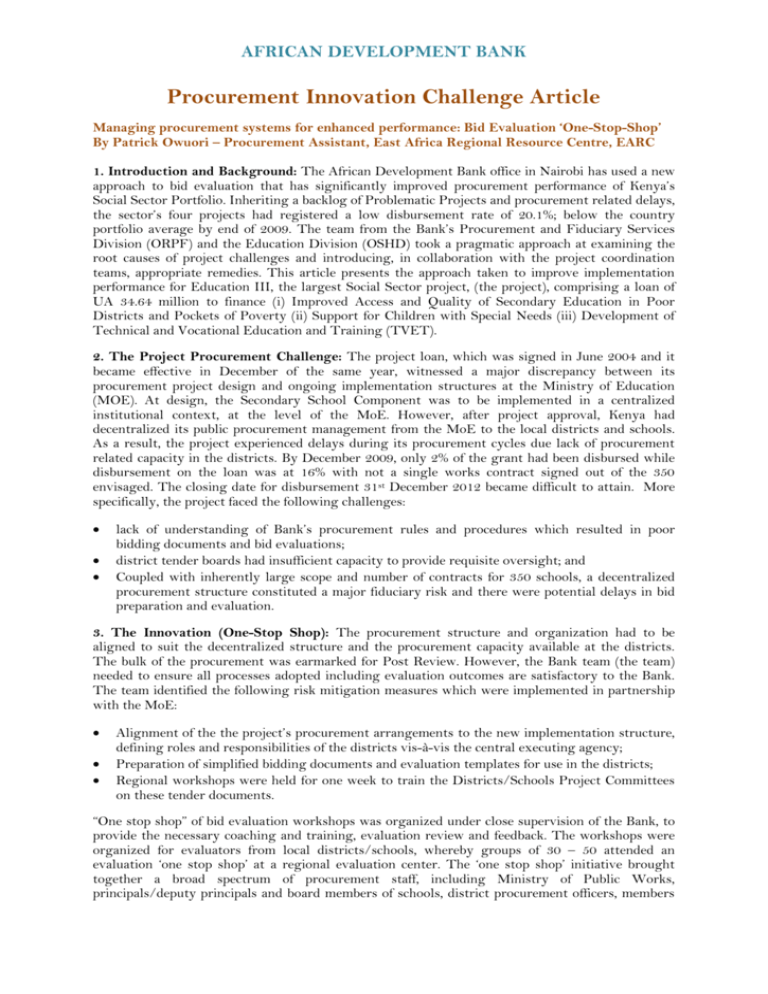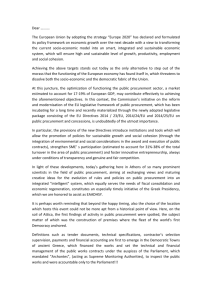AFRICAN DEVELOPMENT BANK Procurement Innovation
advertisement

AFRICAN DEVELOPMENT BANK Procurement Innovation Challenge Article Managing procurement systems for enhanced performance: Bid Evaluation ‘One-Stop-Shop’ By Patrick Owuori – Procurement Assistant, East Africa Regional Resource Centre, EARC 1. Introduction and Background: The African Development Bank office in Nairobi has used a new approach to bid evaluation that has significantly improved procurement performance of Kenya’s Social Sector Portfolio. Inheriting a backlog of Problematic Projects and procurement related delays, the sector’s four projects had registered a low disbursement rate of 20.1%; below the country portfolio average by end of 2009. The team from the Bank’s Procurement and Fiduciary Services Division (ORPF) and the Education Division (OSHD) took a pragmatic approach at examining the root causes of project challenges and introducing, in collaboration with the project coordination teams, appropriate remedies. This article presents the approach taken to improve implementation performance for Education III, the largest Social Sector project, (the project), comprising a loan of UA 34.64 million to finance (i) Improved Access and Quality of Secondary Education in Poor Districts and Pockets of Poverty (ii) Support for Children with Special Needs (iii) Development of Technical and Vocational Education and Training (TVET). 2. The Project Procurement Challenge: The project loan, which was signed in June 2004 and it became effective in December of the same year, witnessed a major discrepancy between its procurement project design and ongoing implementation structures at the Ministry of Education (MOE). At design, the Secondary School Component was to be implemented in a centralized institutional context, at the level of the MoE. However, after project approval, Kenya had decentralized its public procurement management from the MoE to the local districts and schools. As a result, the project experienced delays during its procurement cycles due lack of procurement related capacity in the districts. By December 2009, only 2% of the grant had been disbursed while disbursement on the loan was at 16% with not a single works contract signed out of the 350 envisaged. The closing date for disbursement 31st December 2012 became difficult to attain. More specifically, the project faced the following challenges: lack of understanding of Bank’s procurement rules and procedures which resulted in poor bidding documents and bid evaluations; district tender boards had insufficient capacity to provide requisite oversight; and Coupled with inherently large scope and number of contracts for 350 schools, a decentralized procurement structure constituted a major fiduciary risk and there were potential delays in bid preparation and evaluation. 3. The Innovation (One-Stop Shop): The procurement structure and organization had to be aligned to suit the decentralized structure and the procurement capacity available at the districts. The bulk of the procurement was earmarked for Post Review. However, the Bank team (the team) needed to ensure all processes adopted including evaluation outcomes are satisfactory to the Bank. The team identified the following risk mitigation measures which were implemented in partnership with the MoE: Alignment of the the project’s procurement arrangements to the new implementation structure, defining roles and responsibilities of the districts vis-à-vis the central executing agency; Preparation of simplified bidding documents and evaluation templates for use in the districts; Regional workshops were held for one week to train the Districts/Schools Project Committees on these tender documents. “One stop shop” of bid evaluation workshops was organized under close supervision of the Bank, to provide the necessary coaching and training, evaluation review and feedback. The workshops were organized for evaluators from local districts/schools, whereby groups of 30 – 50 attended an evaluation ‘one stop shop’ at a regional evaluation center. The ‘one stop shop’ initiative brought together a broad spectrum of procurement staff, including Ministry of Public Works, principals/deputy principals and board members of schools, district procurement officers, members AFRICAN DEVELOPMENT BANK of district/schools tender boards, who were coached on best practice evaluation procedures. The evaluation “one stop shops” delivered various functions in a structured workflow: The team and MoE trained evaluators on Bank’s evaluation procedures based on simplified evaluation templates; The evaluators prepared bid evaluations and accordingly; The EA team reviewed evaluation reports and provided immediate feedback at the ‘one stop shop’. The Bank procurement and OSHD staff had attended the workshops to review evaluations cleared for submission to the Bank by the executing agency, thus fast-tracking the Bank’s evaluation prior and post review process for a subsequent provision of a ‘No Objection’. In addition, the one stop shop facilitated the delivery of other project components. The team used the works workshop opportunities to train the districts/Schools teams on identification of bursary beneficiaries under the project and the required justification documents for the same. Furthermore, the Bank team worked with the EA team on major project outstanding tenders for goods. 4. Effectiveness and Results: This “one stop shop” approach to evaluation was useful in reducing the lead time taken to prepare evaluation reports, review and clearing. It also allowed minimizing fiduciary risks by ensuring appropriate evaluation procedures and eliminating any unacceptable practices. The one stop shop served as a hub where all contracts were evaluated and cleared according to the Banks’ rules and procedures. Procurement efficiency: The evaluation workshops substantially reduced the overall procurement lead time of Education III contracts from 370 days in 2009 to 92 days in 2011, and the bid evaluation lead time from 100 days to one week. Improved project implementation: By March 2012, the project had shown considerable progress: (i) 333 works contracts had been awarded and construction works commenced and expected to be completed on time; (ii) works completed and handed over in 16 schools; (iii) 100% of the total works contracts advertised (works in 17 schools have to be re-tendered and an additional 93 contracts have been identified); (iv) Bursary beneficiaries identified and bursary first tranche funds disbursed; (v) Batch 1 Learning and teaching materials for Non Formal Centers and Youth Polytechnics(YPs) procured; (vi) YP works tendered, awarded and works commenced in 9 of the 10 target YPs; and (vi) Equipment for children with special needs and laboratory equipment procured. Improved Disbursement Rate: the project’s disbursement rate is currently at 42 % for the grant (up from 35% in December 2011 and 2% in 2009) and 30% for the loan (up from 17% in 2011 and 16% in 2009). With the abovementioned procurements including works, the loan is expected to improve further to 50% by 3rd quarter 2012. The bulk of the loan funds support works and since these are short, 4-month contracts, all works are expected to be complete by the project closing date. The expected outcomes of this project are likely to be achieved as the project outputs will be attained timely and effectively. The outcomes include to increase physical access and improve the conditions for the teaching of Science and Mathematics across 350 secondary schools in poorer areas of the country; to provide more access and learning opportunities in Secondary and Non-Formal education centers to disadvantaged children and those with special educational needs to acquire appropriate basic education; contribute to the development of a more relevant and appropriate national Technical and Vocational Education and Training (TVET) system through the strengthening of support services and the revitalization of 10 youth polytechnics for more effective vocational skills. AFRICAN DEVELOPMENT BANK Considering the benefits from the evaluation “one stop shop”, the Bank team is using the same approach in other two social sector projects that pose similar procurement challenges.








